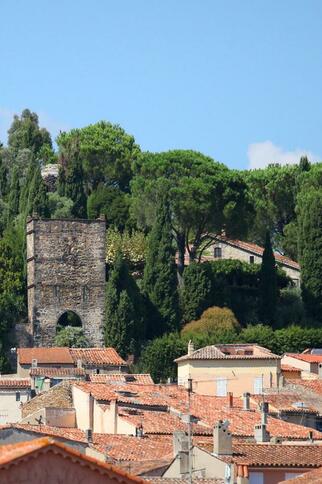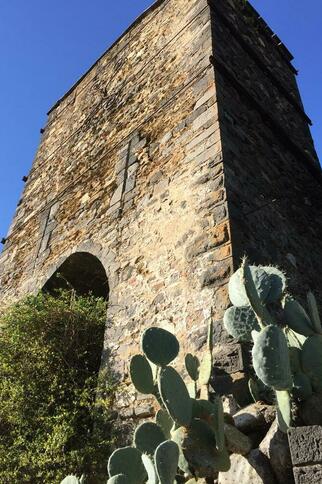Cogolin
Cogolin’s clock tower and boundary wall constituted a defensive system which enclosed the local houses and the seigniorial château. This gate tower, dating from the late 13th to early 14th centuries, was one of the entrances to the village. Access was gained along a ramp, then over a draw-bridge across a moat. Cogolin’s clock tower and boundary wall constituted a defensive system which enclosed the local houses and the seigniorial château. This gate tower, dating from the late 13th to early 14th centuries, was one of the entrances to the village. Access was gained along a ramp, then over a draw-bridge across a moat. A portcullis, known as a sarrasine, protected the village in the event of danger.
This tower was constructed with basalt, a porous, dark grey lava stone, and the rock on which the village of Cogolin was founded.
In the early 14th century the village of Cogolin had a population of around 500.
In the second half of the 16th century, a clock was installed at the top of this tower. One person, usually a locksmith, was appointed and paid by the local community to “run the clock”.
This fragile mechanism operated with a balance weight and required regular repairs. The hours were sounded by a bell dating from 1587.
During the French Revolution, this bell was saved because it was part of a civil building, and therefore was not melted down to make weapons for the Republic. It can be found today in the bell tower of the parish church. Its Latin dedication Sancta Maria ora pro nobis, means ‘Saint Mary, pray for us’. In 1911, the municipal council decided to buy a new clock, which was eventually installed on the pediment of the town hall in 1930.
This tower was constructed with basalt, a porous, dark grey lava stone, and the rock on which the village of Cogolin was founded.
In the early 14th century the village of Cogolin had a population of around 500.
In the second half of the 16th century, a clock was installed at the top of this tower. One person, usually a locksmith, was appointed and paid by the local community to “run the clock”.
This fragile mechanism operated with a balance weight and required regular repairs. The hours were sounded by a bell dating from 1587.
During the French Revolution, this bell was saved because it was part of a civil building, and therefore was not melted down to make weapons for the Republic. It can be found today in the bell tower of the parish church. Its Latin dedication Sancta Maria ora pro nobis, means ‘Saint Mary, pray for us’. In 1911, the municipal council decided to buy a new clock, which was eventually installed on the pediment of the town hall in 1930.
Prestations
Free access.
€ - €
Booking Direct
04 94 55 01 10
cogolin@golfe-sainttropez-tourisme.fr
www.golfe-sainttropez-tourisme.fr
- En centre historique
- Town location
- French
Address
Tour de l'Horloge
Montée des Aloès
83310 Cogolin
Montée des Aloès
83310 Cogolin
Opening
All year round, daily.
-
April 2024
L M M J V S D -
May 2024
L M M J V S D -
June 2024
L M M J V S D -
July 2024
L M M J V S D -
August 2024
L M M J V S D -
September 2024
L M M J V S D -
October 2024
L M M J V S D -
November 2024
L M M J V S D -
December 2024
L M M J V S D -
January 2025
L M M J V S D -
February 2025
L M M J V S D -
March 2025
L M M J V S D -
April 2025
L M M J V S D




